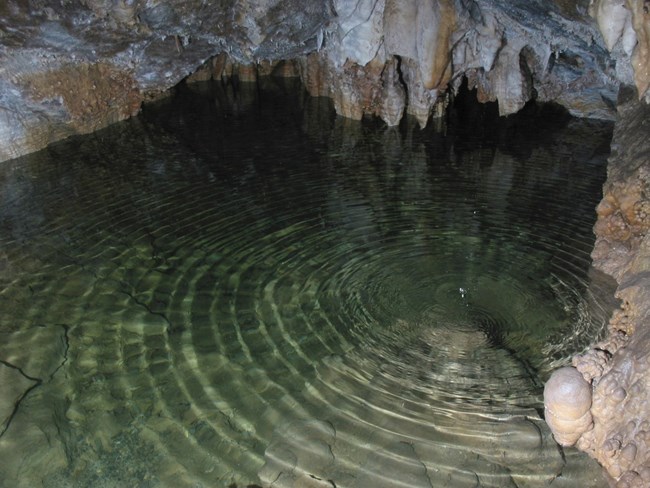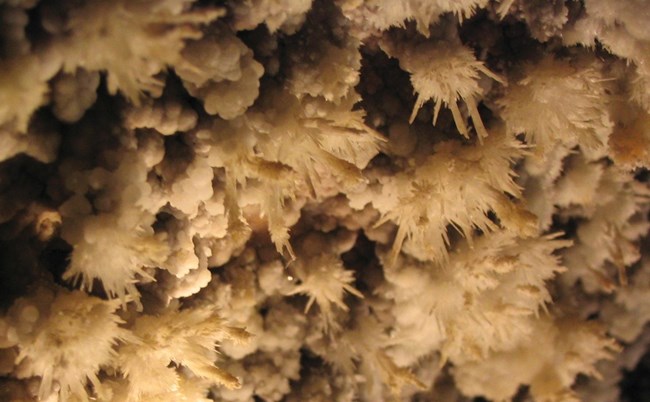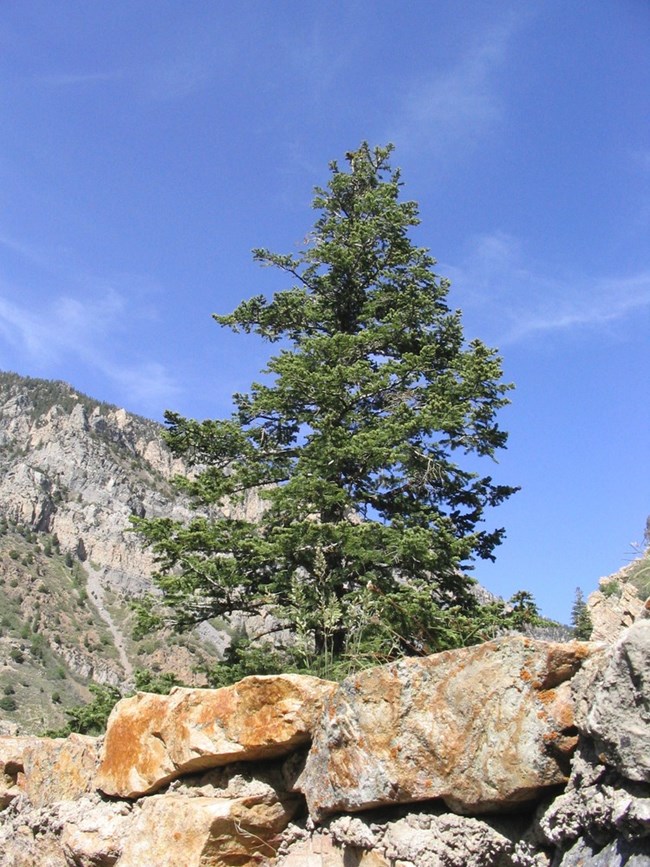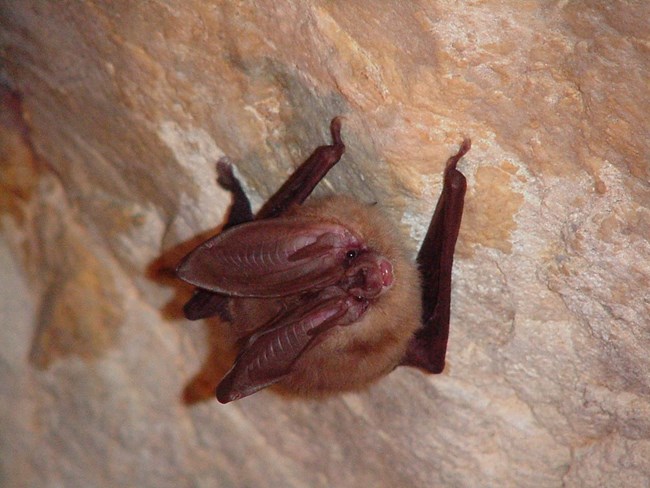The following information is summarized from the Northern Colorado Plateau Network monitoring plan, published in 2004. Some details may have changed.
Park Purpose and History

NPS
Timpanogos Cave National Monument was established by Presidential Proclamation No. 1640, signed by President Warren G. Harding on October 14, 1922. The Proclamation reserved Timpanogos Cave due to its “unusual scientific interest and importance,” stating that “the public interests will be promoted by reserving [the] cave with as much land as may be necessary for the proper protection thereof.” At the time, the Timpanogos Cave system was within the Wasatch National Forest and managed by the U.S. Forest Service. The Proclamation clarifies the management differences between the Monument and the Forest by stating that the reservation of land for the National Monument was “not intended to prevent the use of the lands for the National Forest purposes under the proclamation establishing the Wasatch National Forest, and the two reservations shall both be effective on the land withdrawn but the National Monument…shall be the dominant reservation.”
Executive Order No. 6166, dated June 10, 1933, placed all national monuments under the jurisdiction of the Department of the Interior. On July 1, 1934, Timpanogos Cave National Monument was transferred to the National Park Service. In doing so, the lands within Timpanogos Cave National Monument fell under the provisions of the Organic Act of 1916. The Organic Act requires that national park units be managed in a manner that conserves their natural and cultural resources and provides for the use and enjoyment of current and future generations. The Organic Act provides additional purpose to Timpanogos Cave National Monument, but the Proclamation of 1922 remains the dominant reservation purpose.
Location
Utah County, Utah, about 19 kilometers (12 miles) east of Lehi.
Elevation
Elevations range from a low of 1,670 meters (5,480 feet) along the western boundary to 2,454 meters (8,050 feet) on a peak along the southern boundary.
Size
101 hectares (250 acres)

NPS
General Description
The Timpanogos Cave system is located on the south side of the steep-walled American Fork Canyon, in the center of the Wasatch Range. The caves are accessed by a 2.4-kilometer (1.5-mile) paved trail that gains 325 vertical meters (1,065 vertical feet), placing visitors at 2,042 meters (6,700 feet). The cave system consists of three main caves: Hansen Cave, Middle Cave, and Timpanogos Cave. Each cave has its own natural entrance, but human-made tunnels connect all three. The tunnels create a one-way tour approximately 550 meters (1,800 feet) long. There is a total of 1,706 meters (5,600 feet) of passage in the cave system, with a vertical relief of 56 meters (185 feet). The caves are located an average of 46–122 meters (150–400 feet) below the surface and range in temperature from 43° to 49°F.
The caves formed along three minor faults and the bedding planes in the Tetro and Uncle Joe Members of the Deseret Formation. They are highly decorated and well known for vibrant colors, profusion of delicate helictites and anthodites, unique origin, and rich cultural history.
American Fork Canyon’s geologic history is still debated. The canyon’s location marks the convergence of the Great Basin, Uinta Basin, Wasatch Range, and Uinta Mountains. This area provides the opportunity to view significant geologic features and forces, such as Utah’s basin/range topography, distinctive bedding planes, a maze of faults, fault blocking, karst topography, cave formation, and tectonic plate folding. The steep walls of American Fork Canyon exemplify a V-canyon and expose many thousands of feet of sedimentary rock. These rocks include Precambrian quartzite, Cambrian quartzite, shale, and limestones, dolomites, and minor sandstones. The bulk of the known cave system is confined to the Mississippian-age Deseret Limestone.The monument’s vertical relief from the visitor center to the caves takes visitors not only through geologic history, but also through various biological classes. The flora transitions from riparian environment to cliff-dwelling xeric plants, mingled with a mesic forest at the caves. Near the caves, water seeps from the rocks and provides a prime environment for mosses and ferns among sagebrush and Gambel oak. The fauna makes a less marked transition, but the change can be noted.

NPS
Visitors can discover various species at the monument: two amphibian species, 128 bird species, 61 mammal species, six reptile species, and over 250 vascular plant species.
Plant communities include pinyon-juniper, mountain brush (Gambel oak, big-toothed maple, and serviceberry), white fir and Douglas-fir (restricted to north-facing slopes), and riparian areas with cottonwood, alder, box elder, and red-osier dogwood.
Aquatic features include waterways associated with the American Fork River and cave lakes. A very short section (0.7 mile) of the American Fork River flows through the monument. The steep mountain terrain produces heavy spring runoff with snowmelt in the mountains. Brown, rainbow, and cutthroat trout are present in the river.The Timpanogos Cave system contains three main bodies of water (Hansen Cave Lake, Middle Cave Lake, and Hidden Cave Lake), along with several seasonal smaller bodies of water. Surface waters within the cave appear to be generally of good quality, with some impact from human activities.
Unique Features
The Timpanogos Cave system is a human-made joining of three natural caves that contain 42 types of cave formations, an unusually large variety. The cave features dramatic and rare colors and unusual combinations of delicate helictites and anthodites in quantities not found in other developed, NPS-managed caves.
The Timpanogos Cave system is believed to be the result of rising thermal waters contacting the water table at the intersection of geologic bedding planes and faults. This process is unusual among caves managed by the National Park Service. The caves are heavily decorated with fantastic combinations of colors and formations created through the dissolution and subsequent deposition of minerals at varied depths, percolation rates, and infiltration methods.The 2.4-kilometer (1.5-mile) paved trail ascends 325 meters (1,065 feet) from Precambrian through late Mississippian-aged rocks, providing one of the best exposed, easiest accessed, and most varied geologic records in the nation.

NPS
Resource Management Concerns
Species of Special Concern
Threatened or endangered species have not been identified, but sensitive species and species identified as sensitive exist. A complete T&E survey has never been conducted. Townsend's big-eared bats (Corynorhinus townsendii) are occasional visitors in the caves and other locations.
Invasive Plants
The introduction and spread of invasive exotic plant species is a growing concern. Current problems include Dalmatian toadflax (Linaria genistifolia), spotted knapweed (Centaurea maculosa), houndstongue (Cynoglossum officinale), and small locations of hoary cress (Cardaria draba).
Visitor Use
Related to the invasive species concern is concern over visitor-use impacts. While cave tours have been at near capacity for a number of years, the canyon and monument have been receiving more visitors each year. The monument is located within an hour’s drive of 1.6 million people. The transition from a rural monument to an urban one carries concerns about possible impacts on various resources currently maintained.
Last updated: July 1, 2025
